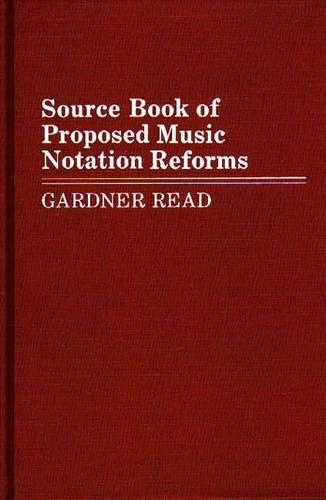
Source Book of Proposed Music Notation Reforms
(Hardback)
Publishing Details
Source Book of Proposed Music Notation Reforms
Bloomsbury Publishing PLC
Greenwood Press
3rd April 1987
United States
Classifications
Tertiary Education
Non Fiction
781.2409
Physical Properties
Hardback
489
Width 156mm, Height 235mm
907g
Description
This is the first book to examine comprehensively the major systems of musical notation proposed during the past three centuries. Illustrating the many attempts to improve upon or replace the traditional system, this important work chronologically lists, describes, and critically analyzes the majority of the proposed reforms that have appeared over the years. No other book now available covers the subject in such depth or detail. It is not only a repository of suggested improvements in notation, but also a historical survey of the efforts made to simplify the standard practices.
Reviews
A desire to cleanse the impurities besmirching traditional musical notation has long intrigued musicians, scientists, mathematicians, acousticians, and philosophers. Read presents an impressive survey of 961 proposed notational reforms that appeared between 1657 and 1983. The book is divided into sections that chronologically describe proposals that espouse staff reforms, clef and register changes, new notehead designs for pitch and duration, numerical systems, and stenographic systems.... All entries include bibliographic information, and most are accompanied by an illustrative passage in both traditional notation and the proposed system. In addition, each proposal is followed by an evaluation of its relative merits or shortcomings, wherein Read comments shrewdly on the proposed system in particular and notational systems in general. There are nine appendixes of useful comparative tables. The scope and uniqueness of this compendium make it a valuable and fascinating reference item. Upper-division and graduate collections.-Choice
Read has produced a compendium that lists, describes, and critically analyzes' 391 of these mostly now-forgotten notational systems, including alphabetical and numerical notation, stenographic systems, and various types of staff, clef, pitch, register, and durational reforms.... The author has not simply produced a compendium; he has digested an enormous quantity of abstruse material and has drawn together historical lines of development.... It is Read's comments that make this esoteric book so valuable. Although it is not a history of notational reforms, this compendium of roads not taken' will be essential to anyone writing that history.-Cum Notis Varcorum
"Read has produced a compendium that lists, describes, and critically analyzes' 391 of these mostly now-forgotten notational systems, including alphabetical and numerical notation, stenographic systems, and various types of staff, clef, pitch, register, and durational reforms.... The author has not simply produced a compendium; he has digested an enormous quantity of abstruse material and has drawn together historical lines of development.... It is Read's comments that make this esoteric book so valuable. Although it is not a history of notational reforms, this compendium of roads not taken' will be essential to anyone writing that history."-Cum Notis Varcorum
"A desire to cleanse the impurities besmirching traditional musical notation has long intrigued musicians, scientists, mathematicians, acousticians, and philosophers. Read presents an impressive survey of 961 proposed notational reforms that appeared between 1657 and 1983. The book is divided into sections that chronologically describe proposals that espouse staff reforms, clef and register changes, new notehead designs for pitch and duration, numerical systems, and stenographic systems.... All entries include bibliographic information, and most are accompanied by an illustrative passage in both traditional notation and the proposed system. In addition, each proposal is followed by an evaluation of its relative merits or shortcomings, wherein Read comments shrewdly on the proposed system in particular and notational systems in general. There are nine appendixes of useful comparative tables. The scope and uniqueness of this compendium make it a valuable and fascinating reference item. Upper-division and graduate collections."-Choice
Author Bio
GARDNER READ is Professor Emeritus at Boston University School for the Arts and a well-known composer, lecturer, and writer.
